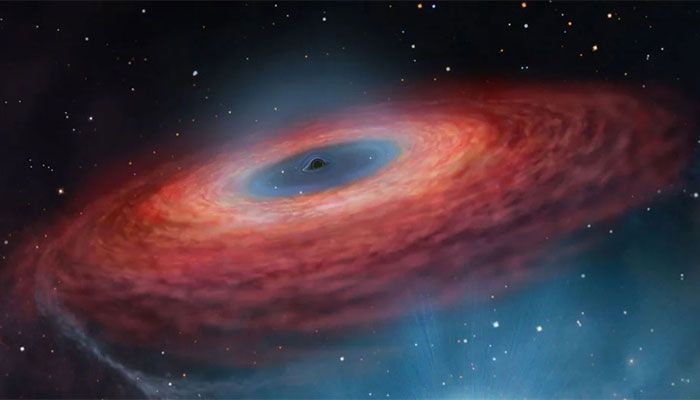
Desk Report
Publish: 23 Sep 2022, 12:34 pm

Image: Collected
Using the Atacama Large Millimeter/submillimeter Array (ALMA), astronomers have spotted signs of a 'hot spot' orbiting Sagittarius A*, the black hole at the centre of our galaxy. The finding helps better understand the enigmatic and dynamic environment of our supermassive black hole, reports AFP.
"We think we're looking at a hot bubble of gas zipping around Sagittarius A* on an orbit similar in size to that of the planet Mercury, but making a full loop in just around 70 minutes. This requires a mind blowing velocity of about 30 per cent of the speed of light!" says Maciek Wielgus of the Max Planck Institute for Radio Astronomy in Bonn, Germany, who led the study published today in Astronomy and Astrophysics.
The observations were made with ALMA in the Chilean Andes -- a radio telescope co-owned by the European Southern Observatory (ESO) -- during a campaign by the Event Horizon Telescope (EHT) Collaboration to image black holes.
In April 2017 the EHT linked together eight existing radio telescopes worldwide, including ALMA, resulting in the recently released first ever image of Sagittarius A*. To calibrate the EHT data, Wielgus and his colleagues, who are members of the EHT Collaboration, used ALMA data recorded simultaneously with the EHT observations of Sagittarius A*.
To the team's surprise, there were more clues to the nature of the black hole hidden in the ALMA-only measurements.
By chance, some of the observations were done shortly after a burst or flare of X-ray energy was emitted from the centre of our galaxy, which was spotted by NASA's Chandra Space Telescope. These kinds of flares, previously observed with X-ray and infrared telescopes, are thought to be associated with so-called 'hot spots', hot gas bubbles that orbit very fast and close to the black hole.
"What is really new and interesting is that such flares were so far only clearly present in X-ray and infrared observations of Sagittarius A*. Here we see for the first time a very strong indication that orbiting hot spots are also present in radio observations," says Wielgus, who is also affiliated with the Nicolaus Copernicus Astronomical Centre, Poland and the Black Hole Initiative at Harvard University, USA.
"Perhaps these hot spots detected at infrared wavelengths are a manifestation of the same physical phenomenon: as infrared-emitting hot spots cool down, they become visible at longer wavelengths, like the ones observed by ALMA and the EHT," adds Jesse Vos, a PhD student at Radboud University, the Netherlands, who was also involved in this study.
The flares were long thought to originate from magnetic interactions in the very hot gas orbiting very close to Sagittarius A*, and the new findings support this idea. "Now we find strong evidence for a magnetic origin of these flares and our observations give us a clue about the geometry of the process. The new data are extremely helpful for building a theoretical interpretation of these events," says co-author Monika Mo?cibrodzka from Radboud University.
ALMA allows astronomers to study polarised radio emission from Sagittarius A*, which can be used to unveil the black hole's magnetic field. The team used these observations together with theoretical models to learn more about the formation of the hot spot and the environment it is embedded in, including the magnetic field around Sagittarius A*. Their research provides stronger constraints on the shape of this magnetic field than previous observations, helping astronomers uncover the nature of our black hole and its surroundings.
Subscribe Shampratik Deshkal Youtube Channel
© 2024 Shampratik Deshkal All Rights Reserved. Design & Developed By Root Soft Bangladesh